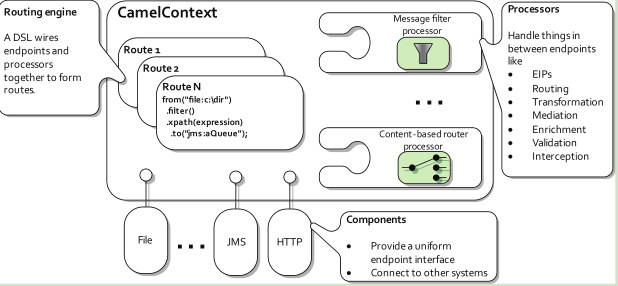1.4 Camel’s architecture
Let’s now turn our attention to Camel’s architecture. We’ll first take a look at the high-level architecture and then drill down into the specific concepts. After you’ve read this section, you should be caught up on the integration lingo and be ready for chapter 2, where we’ll explore Camel’s routing capabilities.
1.4.1 Architecture from 10,000 feet
We think that architectures are best viewed first from high above(高空俯视). Figure 1.6 shows a high-level view of the main concepts that make up Camel’s architecture.

At a high level, Camel is composed of processors, components, and routes.
All of these are contained within the CamelContext(他们都被包含在camel上下文中)。
The routing engine uses routes as specifications for where messages are routed.(消息进行路由交换时,路由引擎把routes当做载体)
Routes are defined using one of Camel’s domain-specific languages ( DSL s). (Routes是由一种camel的领域类语言定义的)
Processors are used to transform and manipulate messages during routing and also to implement all the EIP patterns, which have corresponding keywords in the DSL languages.(在路由交换过程中,Processors用于传输和处理messages,他也实现在dsl中存在响应关键词的所有的企业集成模式)
Components are the extension points in Camel for adding connectivity to other systems. To expose these systems to the rest of Camel, components provide an endpoint interface.(Components作为camel连通其他系统的拓展节点,为了使camel框架的其他部分和这些系统更加融合,Components提供了端点接口)
来源:oschina
链接:https://my.oschina.net/u/1788192/blog/372928